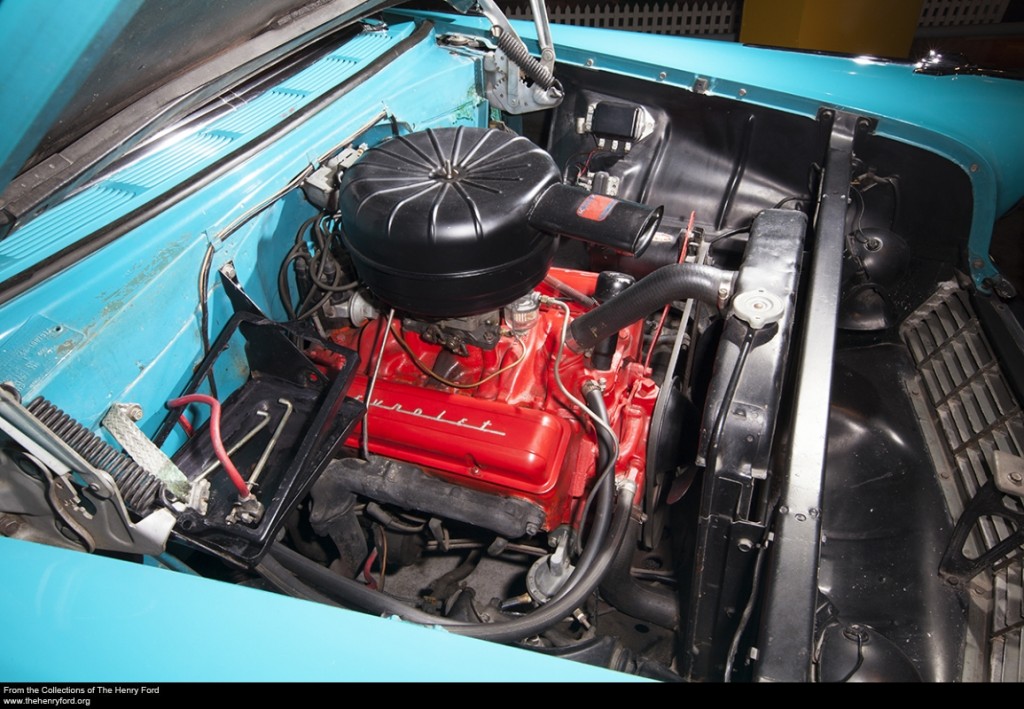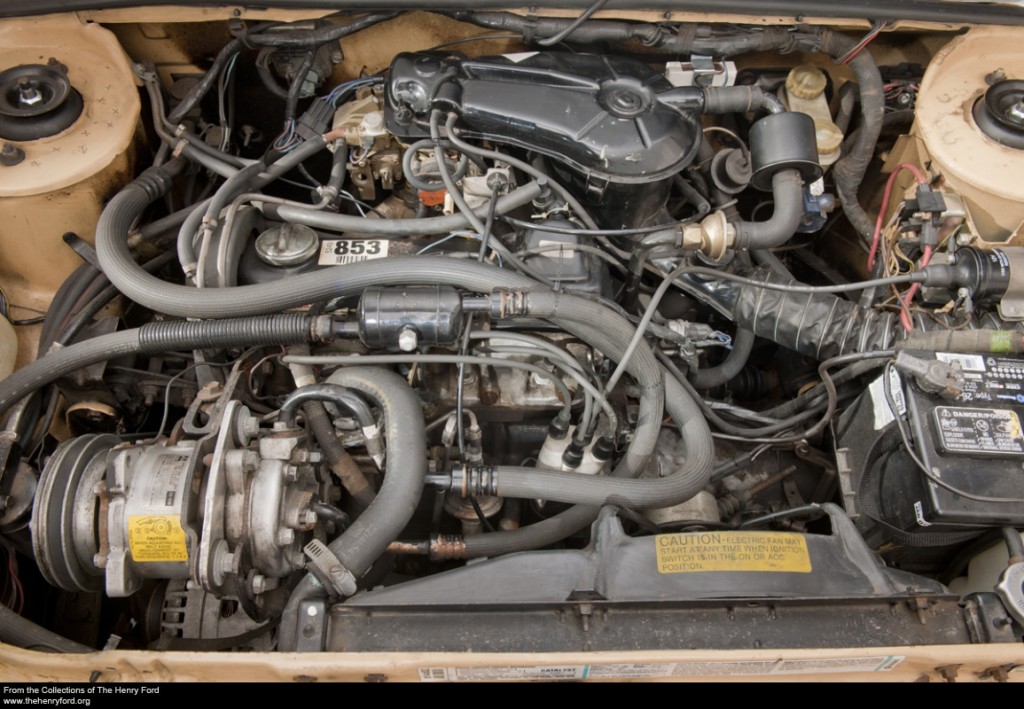Posts Tagged driving america
Engines Exposed: 1960 Chevrolet Corvair

When we look at an automobile, we are moved by what we see on the outside – its styling. But what moves the car is on the inside – its engine. Please join us for a rare look under the hoods of some of the finest automobiles at Henry Ford Museum. More than 40 cars have their engines exposed for you.
Here, Matt Anderson, Curator of Transportation at The Henry Ford, describes some of his favorites.

Engines Exposed: 1960 Chevrolet Corvair
Horizontally opposed 6-cylinder engine, overhead valves, 140 cubic inches displacement, 80 horsepower
Chevrolet took the engine to a place it had rarely been in an American production car – the rear. Much of the motor is hidden by a metal shroud directing air flow from the deck louvers. There are two carburetors, one for each cylinder bank, connected to a single air cleaner at center. Later models increased trunk size up front by moving the spare tire to the engine compartment.
20th century, 1960s, Henry Ford Museum, events, Engines Exposed, engines, Driving America, Chevrolet, cars, by Matt Anderson
Engines Exposed: 1896 Ford Quadricycle

When we look at an automobile, we are moved by what we see on the outside – its styling. But what moves the car is on the inside – its engine. Please join us for a rare look under the hoods of some of the finest automobiles at Henry Ford Museum. More than 40 cars have their engines exposed for you.
Here, Matt Anderson, Curator of Transportation at The Henry Ford, describes some of his favorites.

Engines Exposed: 1896 Ford Quadricycle
Inline 2-cylinder engine, F-head valves, 59 cubic inches displacement, 4 horsepower (estimate)
Henry Ford based the Quadricycle’s engine on the Kane-Pennington motor he saw in American Machinist magazine. Ford brazed water jackets around each of the two horizontal cylinders and mounted wooden water tanks on either side of his engine. The tanks ultimately were replaced with a smaller under-seat reservoir.
Driving America, cars, Henry Ford, Henry Ford Museum, Engines Exposed, quadricycle, engines
Innovation Icon: 1896 Duryea Runabout

It is difficult, and a bit foolhardy, to identify any one car as being the most significant in the history of the American automobile industry. That said, the 1896 Duryea Runabout has a better claim to that title than most. It is the first series-produced automobile made in the United States. While just 13 copies were built, they were just that—identical copies as opposed to singular prototypes or custom orders. Only one of these pioneering vehicles survives today—and it is part of The Henry Ford’s collections.
Brothers Charles E. and J. Frank Duryea typified the mechanically-minded experimenters who built the first American automobiles. Charles entered the bicycle business in 1888, initially in St. Louis before moving to Peoria, Illinois, and then Washington, DC. The younger Frank joined his brother not long after graduating high school in 1888. The brothers were bitten by the auto bug after reading an 1889 article in Scientific American on the pioneering work done in Germany by Karl Benz. After relocating to Springfield, Massachusetts, the Duryea brothers set out to build their own automobile. Continue Reading
engineering, design, making, Henry Ford Museum, Driving America, cars, by Matt Anderson
Lamy's: A Diner from the Golden Age

The 1946 Lamy's diner, as it appears today in Henry Ford Museum. THF77241
Back before diners were considered revered icons of mid-20th-century American culture, Henry Ford Museum's acquisition of a dilapidated 1940s diner raised more than a few eyebrows. Was a diner, from such a recent era, significant enough to be in a museum?

Happily, times have changed. Diners have gained newfound respect and appreciation, as innovative and uniquely American eating establishments. A closer look at Lamy's diner reveals much about the role and significance of diners in 20th-century America. Continue Reading
Massachusetts, 1980s, 1940s, 20th century, restaurants, Henry Ford Museum, food, entrepreneurship, Driving America, diners, by Donna R. Braden
#1 Cars at The Henry Ford

Museums have a habit of collecting “first, last and only” artifacts. Think of things like the ceremonial “First Stone” of the Baltimore & Ohio Railroad at the B&O Railroad Museum. Or the 1966 Cruiser, the last Studebaker automobile ever built, at the Studebaker National Museum. Or the singular airplane Spirit of St. Louis at the National Air & Space Museum. Generally, The Henry Ford’s collection is not marked by “firsts, lasts and onlys.” Don’t get me wrong, we have many unique items (there’s only one Wright Cycle Shop, after all), but Henry Ford concentrated on collecting objects of everyday life. It’s a trait that carries over into our automobile collection. Yes, there are things like the “Sunshine Special” presidential limousine, but ordinary cars like the 1984 Plymouth Voyager or the 1986 Ford Taurus are more typical in the museum – because they were more typical on the road. Continue Reading
An Invention’s Journey to Henry Ford Museum
Inspired by Thomas Edison, Oliver Kuttner has not only driven his Very Light Car into engineering history, he’s also got one parked at the Henry Ford Museum.
Creating something new is arguably one of the most satisfying achievements in life. As engineers, our careers are littered with accounts where we’ve improved designs, given life to concepts and maybe even built something brand new and impactful.
For Edison2 founder Oliver Kuttner, all of those things have happened and his X-Prize winning Very Light Car (VLC) stands in the Henry Ford Museum’s growing collection of engineering marvels.
But unlike many of the stories about engineering brilliance, Oliver’s isn’t one about a lone genius working in solitude. Instead, his story is more modern – it’s one that revolves around inspiration coupled with collaboration. Continue Reading
by Kyle Maxey, Thomas Edison, engineering, environmentalism, Henry Ford Museum, Driving America, cars
Engines Exposed: 1963 Chrysler Turbine
Regenerative gas turbine engine, 130 horsepower.
Chrysler experimented with turbine engines for some 25 years. The Turbine could run on almost anything – gasoline, diesel, kerosene, even peanut oil (with exhaust that smelled like baking cookies)! While the fuel flexibility was terrific, the fuel economy was less than stellar. Chrysler ended the Turbine program in 1979. Note the huge air filter housing in front of the engine. The Turbine gulped about four times more air than a piston engine.
Matt Anderson is Curator of Transportation at The Henry Ford.
1960s, 20th century, Henry Ford Museum, Engines Exposed, engines, Driving America, cars, by Matt Anderson
Engines Exposed: 1956 Chevrolet Bel Air
V-8 cylinder engine, overhead valves, 265 cubic inches displacement, 205 horsepower.
It’s the most enduring 8-cylinder American automobile engine. Chevrolet introduced its “small block” V-8 in 1955 – and kept on building it until 2003. Nearly every General Motors division used some variant, and total production is over 100 million, including later development generations. Not bad for an engine designed in 15 weeks. The compact unit is all but swallowed up by the Chevy’s engine bay. Note the relatively small-sized radiator, too. Efficient cooling was one of the small block’s many advantages.
Matt Anderson is Curator of Transportation at The Henry Ford.
20th century, 1950s, Henry Ford Museum, Engines Exposed, engines, Driving America, convertibles, Chevrolet, cars, by Matt Anderson
Engines Exposed: 1978 Dodge Omni
Inline 4-cylinder engine, overhead valves, 105 cubic inches displacement, 75 horsepower.
Small cars pack a lot into tight spaces. The Omni makes the most of its engine bay by mounting the unit transversely, with the crankshaft parallel to the front bumper. It’s a layout not widely used in American cars since the early 1900s, but particularly well-suited to compact front-wheel drive vehicles. Power is sent to the Omni’s front wheels via the transaxle, a combination gearbox-differential, on the driver’s side.
Matt Anderson is Curator of Transportation at The Henry Ford.
20th century, 1970s, Henry Ford Museum, Engines Exposed, engines, Driving America, cars, by Matt Anderson
Engines Exposed: 1931 Bugatti Type 41 Royale Convertible
Inline 8-cylinder engine, single overhead camshaft, 779 cubic inches displacement, 300 horsepower.
From its length, one might expect more than 8 cylinders under the Bugatti’s hood. But each of those cylinders displaces more than the whole of a Volkswagen Beetle’s power plant. Four air cleaners stand over the engine, fitted to the four carburetors installed by Charles Chayne after World War II. Two spark plugs protrude from each cylinder. The steering box sits just behind the right fender, in keeping with the car’s right-hand drive layout.
Matt Anderson is Curator of Transportation at The Henry Ford.
20th century, 1930s, luxury cars, Henry Ford Museum, events, Engines Exposed, Driving America, convertibles, cars, by Matt Anderson










